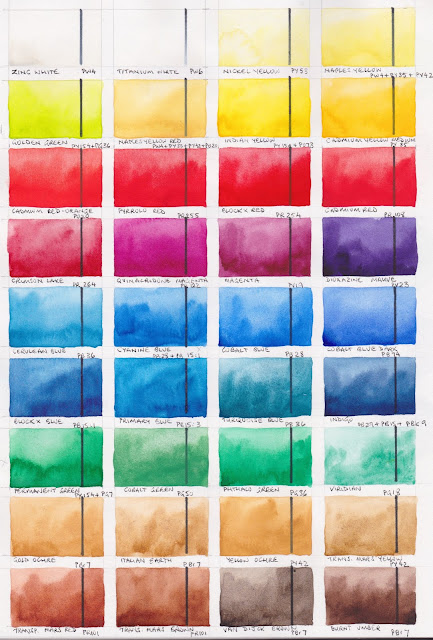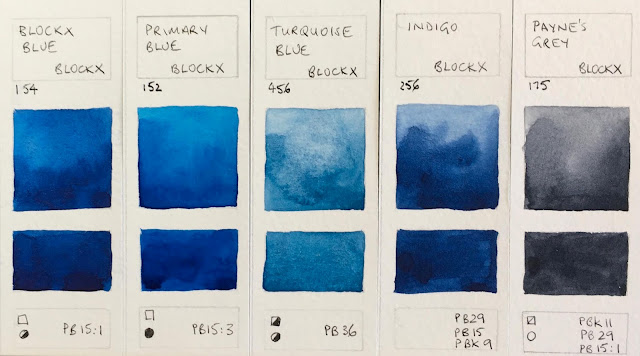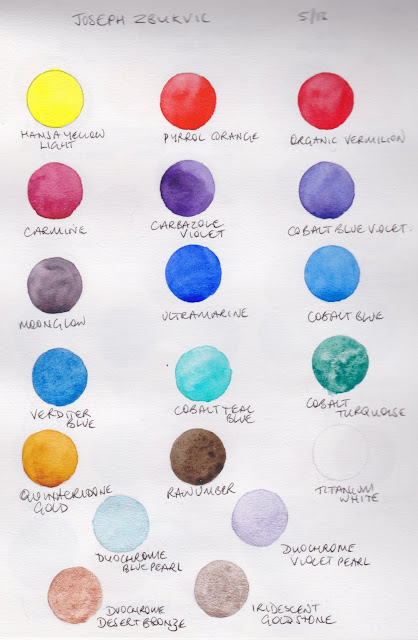I had the opportunity to try out the full 72 colour
Blockx range, and they have all been added to my website, but I thought it may be helpful to be able to see the full range here together as well. The majority of the colours are single pigment colours, mixed with gum Arabic and honey. They come from Belgium and are available in half pans, giant pans, 15ml or 35ml tubes.
 |
| Blockx watercolour full range chart 1 |
There is a good range of colours, with many gorgeous cadmium colours - probably the brightest versions of any brand I have tried - including the less common deep crimson-maroon colour called Cadmium Purple.
Since Cadmiums have been discontinued in many brands it is good to see them still being produced so nicely by Blockx, as while I don't use cadmiums for my general painting, I value them tremendously as excellent pigments when you want a more opaque colour. I keep a supply of the old DS cadmiums in my studio - Cadmium yellow light and deep, Cadmium scarlet and Cadmium red and I've now added the lovely Blockx Cadmium Red-Orange to my studio collection.
Other really lovely colours are the Turquoise Blue and Turquoise Green both made with PB36, a lovely deep blue-purple Ultramarine Violet PV15, and the granulating Manganese Violet PV16.
 |
| Blockx watercolour full range chart 2 |
Some of the watercolours don't re-wet as well as I would like, and they certainly didn't re-wet as well as the Daniel Smith paints I am used to. Some are difficult to use even straight from the tube.
While I don't recommend every colour in the range, I really enjoyed painting them all out. The particularly tricky pigments are difficult in any range - PY53, PG18, PV14 and PG23 in particular i.e. Nickel Yellow, Viridian, Cobalt Violet and Green Earth.
You can see the interesting Cadmium Purple left, but it is actually much stronger than it looks on my screen.
Notice there are two Ultramarines and two burnt siennas - nice to have options. I liked the Burnt Sienna Light best - nice and granulating (both are made with PBr7).
There are only a few mixed pigment colours and I wasn't that interested in any of them, but with so many single pigment paints it's easy to mix your own.
A real plus with this range is that you can try them out buying half pans of colours you may use only a little but buy tubes of those you may use regularly - or large tubes of those you'll use a lot. Note - I haven't tried the pan colours. I expect that if you are in or near Belgium these watercolours should be well-priced. There are sets available on Amazon.com but they contain some less useful colour combinations so it may be better to choose your own.
October 2018
I have been working my way through my many lists of updates I have wanted to do, and one was to photograph and add these swatches. I'll leave the above versions since they are painted over a black line, but add the more detailed ones below.
The Lemon Yellow is a really lovely bright version.
 |
Block Watercolours - Zinc White, Titanium White, Nickel Yellow, Naples Yellow, Lemon Yellow.
|
The first three here are all brighter than they look on my screen. The Primary Yellow would be a great choice for a limited palette.
 |
| Block Watercolours - Blockx Yellow, Cadmium Yellow Pale, Primary Yellow, Golden Green, Naples Yellow Red. |
This set are also brighter than they appear on my screen - beautiful warm yellows and oranges. Gamboge is a lovely choice for a warm yellow.
 |
| Block Watercolours - Indian Yellow, Cadmium Yellow Medium, Gamboge, Cadmium Yellow Orange, Permanent Orange. |
Pyrrolo Red is made from my favourite warm yellow pigment PR255. Blockx Red is a gorgeous bright fire engine red.
 |
| Block Watercolours - Pyrrolo Vermilion, Cadmium Red-Orange, Pyrrolo Red, Blockx Red, Cadmium Red. |
Rose Pale Lake and Rose Lake are almost indistinguishable. Either works as a primary red or a cool red in a larger palette. Crimson Lake is my favourite crimson pigment.
 |
| Block Watercolours - Cadmium Purple, Quinacridone Red, Rose Pale K=Lake, Rose Lake, Crimson Lake. |
This set is pretty true to colour. I love the granulation of Manganese Violet.
 |
| Block Watercolours - Quinacridone Magenta, Magenta, Dioxazine Mauve,Manganese Violet, Cobalt Violet. |
This is a lovely version of PV15, which can often be very weak.
 |
Block Watercolours - Ultramarine Violet, Cerulean Grey, Cerulean Blue, Cyanine Blue, Cobalt Blue.
 |
| Block Watercolours - Cobalt Blue Dark, French Ultramarine Blue Deep, French Ultramarine Light, Prussian Blue, Indanthrene Blue. |
|
 |
| Block Watercolours - Blockx Blue, Primary Blue, Turquoise Blue, Indigo, Payne's Grey. |
I like the fact that there are largely single pigment greens in this range, with a range of characteristics.
 |
| Block Watercolours - Turquoise Green, Chrome Green, Blockx Green, Permanent Green, Cobalt Green. |
 |
| Block Watercolours - Phthalo Green, Viridian, Green Earth, Sap Green, Hooker's Green. |
 |
Block Watercolours - Olive Green, Gold Ochre, Italian Earth, Yellow Ochre, Transparent Mars Yellow.
|
 |
| Block Watercolours - Burnt Sienna Light, Burnt Sienna Deep, Light Red, Venetian Red, Transparent Mars Red. |
 |
| Block Watercolours - Transparent Mars Brown, Van Dijck Brown, Burnt Umber, SEpai. |
 |
| Block Watercolours - Neutral Tine, Ivory Black, Lamp Black. |
Happy painting :-)

 From Hong Kong I flew into Paris. I have some wonderful relatives on my sister's side I was able to meet up with, along with some of the Paris urban sketchers and friends from the Sketchbook Skool community.
From Hong Kong I flew into Paris. I have some wonderful relatives on my sister's side I was able to meet up with, along with some of the Paris urban sketchers and friends from the Sketchbook Skool community.



 We spent a very enjoyable morning at the gardens of the Musee de Rodin, where I loved seeing The Kiss again. I drew it as an assignment while at school, along with a number of other very famous sculptures, which seem like old friends whenever I come across them as a consequence. It was great to see our Kiwi friends Alexander and Linda while we were there. I did a very quick sketch of The Thinker and we headed off on our next expedition.
We spent a very enjoyable morning at the gardens of the Musee de Rodin, where I loved seeing The Kiss again. I drew it as an assignment while at school, along with a number of other very famous sculptures, which seem like old friends whenever I come across them as a consequence. It was great to see our Kiwi friends Alexander and Linda while we were there. I did a very quick sketch of The Thinker and we headed off on our next expedition.




































